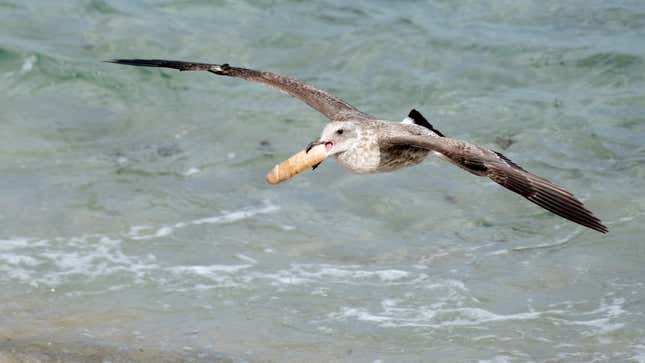
Conservation photographer Jennifer Warner visited the Children’s Pool in La Jolla, California on Tuesday in order to photograph the pupping harbor seals that have taken up residence on the beach. She soon noticed some juvenile gulls chasing each another around and causing a ruckus; one of them had what she thought at first was a piece of plastic pollution in its beak. She snapped a few photos and zoomed in.
The gulls were fighting over a dildo.

“Before realizing what the object was, I was annoyed and mad, because plastic pollution is a real serious problem, and as a conservation photographer I’m documenting human impacts on wildlife,” Warner told Gizmodo. “But when I realized what it was, while the other emotions still existed, you can’t help but find humor in it.”
Seals have used this stretch of beach as a breeding refuge since at least 1996, the San Diego Union-Tribune reports. The city closed the beach for five months in 2014, but residents sued to have it reopened. A judge ruled that the city could once again close the beach for pupping season in 2018. But the seals aren’t the only animals that have found refuge here; other wildlife, like the gulls, take advantage of the peaceful habitat as well.

Gulls aren’t just beach-loafing french-fry stealers. They provide important ecosystem services, cleaning up the afterbirth from the seals on the beach, for example. But they’re also cunning, playful birds. Warner watched the juveniles tossing the dildo and chasing one another around until one of the birds flew away with it, for uses only the gull knows.
Birders in one gull-watching Facebook group identified the birds in question as juvenile western gulls, a dark-backed gull common on western coasts. Though nicknamed seagulls, America’s many gull species inhabit niches around the country, many far from the seashore. Some birders (yours truly included) find enjoyment in observing our many gull species and learning to tell them apart.

As a conservation photographer, Warner strives to document how human and wildlife coexist, including how humans pollute habitats and come into conflict with wild animals. She was happy that these photo are going viral as a way to draw people’s attention to plastic pollution on a beach.
Anyway, if this is your dildo, it has a new owner now.